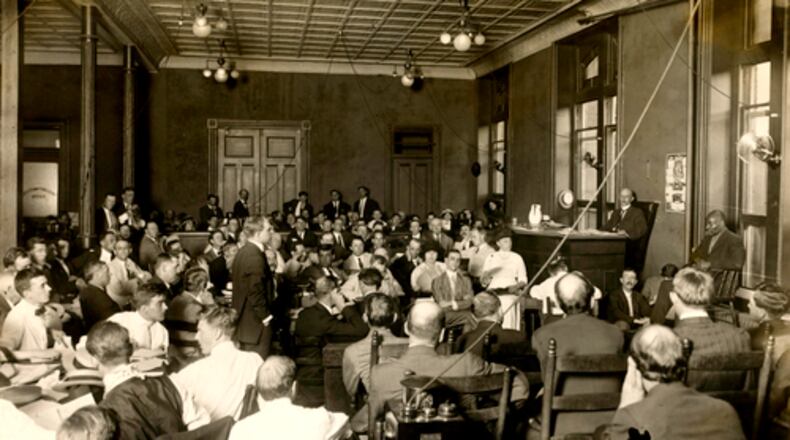It’s the case that won’t go away, the story that embodies Faulkner’s quote that “the past is never dead. It’s not even past.”
The tragic saga of Leo Frank, the Jewish businessman long ago convicted of a heinous crime and lynched, has again found new legs.
The Broadway play “Parade,” written by Atlanta-born author Alfred Uhry and based upon the early-1900s case, recently won a Tony Award for Best Revival of a Musical and Best Direction of a Musical.
“Parade” is a reboot of Uhry’s 1998 Broadway flop. This time, ticket sales were so strong that computers crashed.
The difference? Maybe better marketing. Or perhaps it’s because antisemitism is on the march in this argumentative and divided country. Antisemitic incidents are up a third this year, more so in Georgia, says the Anti-Defamation League. The case is still so contemporary that Neo-Nazis protested outside the New York theater this year, calling Frank a pedophile.
“It’s a 110-year-old story that’s timely again,” said Steve Oney, author of the definitive book on the case, “And the Dead Shall Rise: The Murder of Mary Phagan and the Lynching of Leo Frank. “The Frank case will not go away. It’s kind of the original sin of Georgia.”
In fact, buzz created by “Parade” rocketed Oney’s 20-year-old, 700-page book to No. 1 in Amazon’s true crime sector.
The Dead have Arisen.
I recently read Oney’s book for the second time and thought I’d call him.
During a recent episode of the radio show “Political Rewind,” Oney appeared with Uhry to talk about “Parade” and the Frank case. (The show was recorded just hours before Georgia Public Broadcasting announced its asinine decision to ax “Rewind” and send host Bill Nigut packing.)
As the show warmed up, Nigut asked Uhry about the case. Uhry, the famed author of “Driving Miss Daisy,” paused before saying, “I’m a little gun shy to talk about it with Steve here. Our show was unfortunately written before Steve’s book came out. I wish he was a little quicker with it.”
Oney’s book was a laborious process — 17 years to be precise.
The former Atlanta Journal-Constitution Magazine writer came to the case in 1985 when writing for Esquire magazine. At the time, there was a movement in Georgia to exonerate Frank for the 1913 murder of 13-year-old Mary Phagan, whose strangled body was found in the dank basement of the downtown Atlanta pencil factory that Frank managed.
Phagan worked at the factory, as did scores of young teen girls. Frank was a taciturn “outsider,” a Jew from Brooklyn. The day of her murder, Mary was headed to the Confederate Memorial Day parade, hence the name of Uhry’s play, “Parade.”
I won’t dive deep into facts of the case: One could spend 17 years filling up a 700-page tome doing so. But during the trial, several girl employees testified that Frank leered at them and was not a person of “good character.” A Black employee named Jim Conley, first thought to be a suspect, pointed a finger at Frank and the case shifted forever.
During the trial, jurors heard mobs outside shouting, “Hang the Jew!” He was convicted and sentenced to death.
After the conviction, The New York Times led a campaign to undo the conviction. The story became a national phenom. (Interestingly, a scathing Times review of the 1998 version of “Parade” helped quickly usher it from the Broadway stage.)
Credit: Bob Andres
Credit: Bob Andres
To rebut the Times’ coverage, Tom Watson, the incendiary populist who became a U.S. senator in 1920, went after Frank in his magazine, The Jeffersonian, calling him a “lecherous Jew.” His circulation skyrocketed.
Oney noted it was a time with a “breakdown of verifiable facts.” Sounds familiar, eh?
The trial judge, as well as Conley’s attorney and Gov. John Slaton, all had misgivings about Frank’s guilt. When Slaton commuted Frank’s sentence, a mob stormed the state Capitol and later headed for the governor’s home.
“It was a mob egged on by what was characterized as a miscarriage of justice,” Oney said, likening it to the Jan. 6, 2021 storming of the U.S. Capitol. “Things can get out of hand more quickly than we’d like to think.”
A highly orchestrated crew from Marietta, put together by that town’s elites, drove the 120-plus miles to the prison in Milledgeville, stormed into the facility, hand-cuffed the warden, drove Frank back to Cobb County and strung him up in a tree near where the Big Chicken now stands.
Oney said the trial transcripts, which would have stood 6 feet tall, disappeared from Fulton County court archives in the 1960s. He was left reading two years worth of Atlanta’s three papers from the time: The Journal, The Constitution, and the Hearst-owned Georgian, all which had voluminous and different takes on the proceedings.
There was also a mountain of documents created by the appeals and an untold number of diaries, letters and reminiscences from contemporaries now stored in various institutions.
“It’ll be hard to do this kind of research again,” Oney said. “It’s all pre-digital, all on paper.”
A century later, some things have changed.
About the Author
Keep Reading
The Latest
Featured






